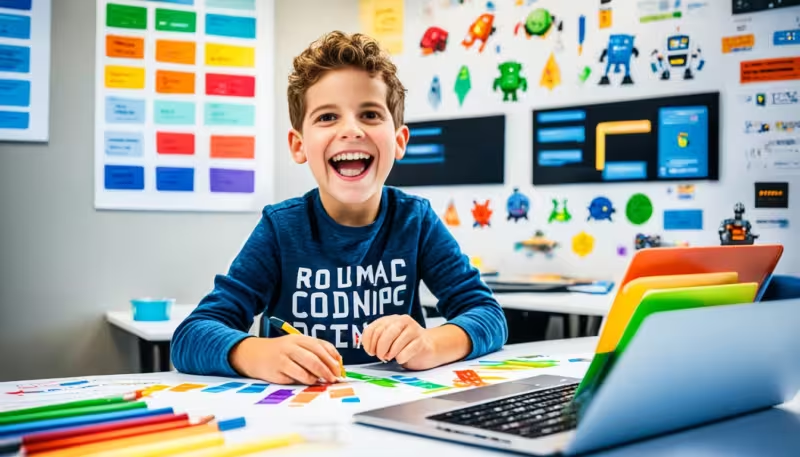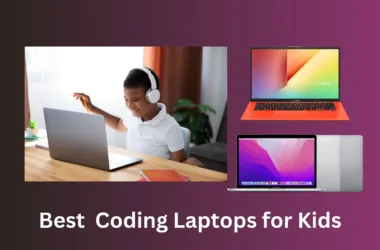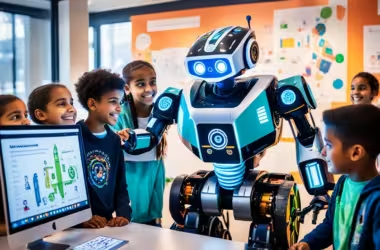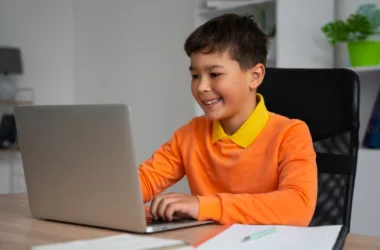Why is coding considered a must-have skill for kids today? In our technology-driven world, coding is key. Teaching kids to code at home prepares them with vital skills and boosts their problem-solving abilities. Resources like Scratch Jr., Codespark, and Kodable allow even 4-year-olds to learn coding. They make coding fun with engaging activities, making complex ideas simple and enjoyable.
Today, we face a future with over 1.4 million programming jobs and a shortage of 1 million programmers. It’s crucial to understand coding. This guide explores the colorful world of coding education for kids. We’ll show you how to get your children excited about coding, laying the groundwork for their success.
Understanding What Coding Is
Coding is how computer programmers tell computers what to do. It looks complex but rests on logic and precision. Through this process, programmers make choices that let computers follow commands.
When we talk about coding, we see many programming languages. For example, Scratch and JavaScript are great for kids, while Python and C++ suit more advanced learners. Coding for kids is like learning a new language, boosting logical thought and creativity.
Many parents and teachers find it hard to get good coding resources. They need help on how to teach coding to kids. But, sites like Scratch, Code.org, CodaKid, Khan Academy, and Codecademy offer educational and fun learning experiences.
As kids dive into coding, they learn essential concepts like conditionals and loops. These fundamentals are key to almost all programming languages. This makes moving from block-based to text-based coding smoother as they advance. For children, coding is both a path to discovery and a step toward a tech-powered future.
The Importance of Coding for Kids
Coding is getting more important for kids’ growth nowadays. It helps them develop critical thinking, creativity, and problem-solving skills. A lot of high schools, about 45%, have started teaching computer science. Back in 2014, this was only 25%. This shows that coding is important in many jobs, not just tech ones.
Learning to code does more than teach tech stuff. It makes kids smarter in many ways. By coding, kids get better at math, solving problems, and even getting along with others. They can make new things from nothing, which boosts their imagination. This helps keep their creativity alive, even as they grow up.
When kids code, they learn how to solve problems in their daily lives. They learn about algorithms, which are steps to solve problems. Coding tasks teach kids to keep trying, even when things get tough. Angela Lee Duckworth, a psychologist, says this grit is key to success. So, coding is more than tech skills. It’s a way to handle life’s big challenges.
There are fun tools that make coding exciting for kids. Sites like Code.org offer cool ways for kids to learn coding. It’s important to balance screen time with other activities. Parents are important in guiding their kids through learning to code. They should promote healthy use of technology and support their children’s interest in coding.
Cultivating Interest in Coding
Making coding interesting for kids can lead to amazing experiences. One way to get kids into coding is by tying it to games they love. If a child likes video games, they might enjoy making their own games through coding. This link helps them explore their creativity while learning to solve problems.
It’s important to remember that kids have short attention spans. They need to see value in what they’re doing to stay interested. Giving them small rewards often can help them focus better. This makes it easier for them to get coding quickly. Making coding fun for them lets kids feel successful, which makes them like coding more.
Knowing that kids like fun tasks means we use methods that keep learning interesting. Parents and teachers can handle the boring parts of projects. This lets kids work on the parts they find exciting. This way, they stay eager to learn more about coding.
- Encourage kids to celebrate their accomplishments
- Provide opportunities for them to share their projects with peers
- Guide them in experimenting at their own pace
Creating a supportive environment helps kids feel proud of what they learn. This boosts their desire to keep learning. Since 89% of parents think computer science helps build vital skills, engaging coding activities have a big impact. They can really change kids’ educational and personal growth for the better.
Teaching Kids Coding at Home: Strategies for Success
Teaching coding to kids can be very fun and educational. Use good methods to make learning coding better for them. It’s important to be patient since coding takes time to learn.
Set Realistic Expectations
Parents need to set achievable goals because coding is complex. Kids might find it hard at times. Stress the fun of learning and encourage them to solve problems by trying different solutions. Celebrating small wins helps keep their interest in coding.
Start with Familiar Concepts
Starting with things kids know can make coding easier to grasp. Say, games or fun coding toys like Sphero link coding to their world. Hands-on activities help kids get the basics of coding. It sparks their creativity. Mixing digital learning with actual items makes learning more engaging and fun.
Choosing the Right Tools for Learning
It’s important to pick the right coding tools for kids to boost their learning. Many excellent coding apps and resources are out there. They engage young minds and spark creativity. Parents can find interactive apps and online courses. This helps create a supportive coding environment at home.
Interactive Apps and Software
Interactive apps make learning to code fun and easy for kids. Scratch and Scratch Jr., for example, let kids build stories and games with block coding. This makes understanding basic programming simple. Other apps worth mentioning include:
- Kodu: Lets kids create games and learn coding skills without prior experience.
- Tynker: Offers courses and projects at the child’s own pace.
- Coding Monster: Great for kids who know basic JavaScript and want more challenges.
- SpriteBox Coding: A popular app among teachers, used by 20 million.
Online Resources and Courses
There are many online coding resources besides apps. Code.org offers courses for kids as young as 4, using puzzles and videos to help understand. Other great online resources include:
- CodeAcademy: Provides interactive coding exercises in various programming languages.
- PluralSight: Features more than 50 coding classes for kids, organized in learning paths.
- Khan Academy: Has tutorials on HTML, CSS, and JavaScript, with courses lasting 15 to 40 hours.
- Blockly: Teaches programming with a visual approach, introducing basic concepts.
Starting with Scratch: The Perfect Introductory Language
Scratch programming is an excellent start for young coders. Its easy, block-based interface makes coding simple. Kids can create interactive stories, animations, and games. This makes learning to code fun and exciting.
Scratch is made for everyone eight and older. It has over 92 million users, offering a place to collaborate. Users find it easy to explore the Scratch interface. It has the Code Editor, Stage, Scripts Area, and Toolbar. These help kids learn key programming ideas.
ScratchJr is great for younger kids, ages 5 to 7. It’s a free app that teaches basic programming. ScratchJr uses simple activities to build thinking and problem-solving skills. It prepares them for more learning. The Scratch Coding Cards provide 75 ways to discover programming.
Super Scratch Programming Adventure! lets kids make their own video games. These games are like classic arcade games. Scratch helps beginners be creative and express themselves. It’s a great first step into coding. It also boosts confidence for learning more complex languages later.
Challenges and Frustrations: How to Overcome Them
Learning to code can be tough, especially for kids. Sometimes, when the concepts get too complicated, they feel overwhelmed. It’s important to have a supportive learning space. This helps turn mistakes into lessons, building resilience and reducing fear.
Allowing kids to learn at their own speed is vital. It lets them handle tough topics their way. Checking in often helps see how they’re doing. This makes it easier to change learning plans if needed. Using games in lessons also keeps coding fun and engaging for them.
Coding programs designed for kids can make learning easier. Using gadgets like Osmo bots or iRobot Root helps young learners grasp technical details. Experts suggest having a special study area. This helps kids focus by reducing distractions.
Adding problem-solving to lessons helps kids use their coding skills better. Teachers and parents need to stress the importance of sticking with it. Overcoming coding frustrations often leads to personal growth.
Finding the Right Teacher or Resource
Finding the right coding teachers for kids is key to sparking their interest in programming. It’s important for parents to look for instructors who know their stuff and love to teach. A teacher who’s really into coding can make even the basic lessons fun and exciting for kids.
There’s a bunch of online coding courses out there. For example, Code.org uses cool maze games to keep students engaged. Scratch has a big community of over 15 million users that helps kids get creative and work together. And for teens, Vidcode is a popular choice, especially for those who like to learn from home.
Choosing the right resources can make a big difference in learning to code. Parents have many options, like:
- Kodable, with games for grades K-5, even for kids who can’t read yet.
- Codecombat.com, which has a free version with 39 levels to get started with coding.
- Crunchzilla.com, offers fun coding lessons beginning with Code Monster for the little ones.
- Codemonkey.com, giving 250 free challenges that let kids code their own games.
These options make it easy for parents to find coding resources that match their child’s interests. With the right help and tools, kids can learn important skills for the future. Good teaching and the best resources can make a big difference in a child’s coding adventure.
Conclusion
Teaching kids to code is more than just giving them a skill. It’s investing in their future. Coding helps kids improve problem-solving and critical thinking. It also opens up many career paths. With 67% of new STEM jobs in computing, coding prepares kids for a fast-changing job market.
There are many great resources to help kids learn to code in fun ways. Tynker is one option, offering over 70 courses and 300 lessons. It helps kids start their coding adventure with fun projects. This way, they can enjoy learning and maybe even love coding for life.
Getting kids into coding sets them up for future success. It’s good to start with easy block coding and then try harder languages. Making learning fun and engaging is key. Parents play a big role in guiding the new generation of thinkers and doers.






